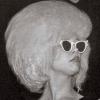Let the Light In: Georgia Museum of Art Exhibits (Virtual) Tiffany Glass

Tiffany Studios, garden landscape window, 1900–10. Leaded glass. Photograph by John Faier. © 2013 The Richard H. Driehaus Museum.
Like other non-essential institutions, most art galleries and museums are presently closed. This is no excuse, however, not to brighten your life with art.
The Georgia Museum of Art has generously converted its current exhibition, “Louis Comfort Tiffany: Treasures from the Driehaus Collection,” into a free virtual show, accessible from the safety of your home. Even if you already saw the exhibit when it first opened on Feb. 1, before the pandemic really took off, you might consider “returning.” As one virtual visitor commented, “Although I got to see it at the museum, I learned even more watching [the digital version].”
The American artist and designer Louis Comfort Tiffany (1848-1933) is best known as the developer of the incomparably beautiful stained glass known as “Tiffany glass.” In a sense, he worked as much with light as glass. He and his employees designed lamps to emit light and windows to let light in. In general, light is merely the agent that allows one to see a work of art, such as an oil painting or marble sculpture. But light is the very essence of an artwork made of stained glass: Light passes through the glass, both illuminating the work itself and casting the surrounding space in its hues. Such an artwork moves beyond its physical boundaries, generating an ambiance or atmosphere that may influence an entire room.
Consequently, it is extremely difficult to replicate the physical presence of a Tiffany lamp or window. Virtually, you can’t see or feel the reflections; you can't notice the iridescent shimmering, the tones shifting with each step you take. Nonetheless, The Georgia Museum of Art, curator David A. Hanks and collection owner Richard H. Driehaus do a laudable job of presenting Tiffany’s work, given these trying circumstances.
The virtual exhibition (which can be seen at tinyurl.com/rkcuze5) is basically a high quality PowerPoint presentation. One by one, photographs of artworks are shown with commentary from Hanks and Driehaus. There are certain advantages to this format. In those photographs that capture multiple pieces at once, one can more easily notice formal and tonal correspondences among several different artworks—something that is often difficult to do during an immersive museum visit.
Moreover, the video’s commentary is not just informative in its presentation of facts about Tiffany’s life and methods; it also reveals an illusion underlying the Tiffany aesthetic, as well as the problematic nature of his business model. “Tiffany himself,” we are told, “did not design most of the lamps; he hired a group of female artists, who he believed had a superior color sense to men.” We should proceed, then, by remembering that “Tiffany” lamps and “Tiffany” windows are not the creations of a singular man of genius named “Tiffany.” They are the products of a team of underpaid, often invisible women. Needless to say, this insidious discrepancy between those who labor and those who reap the fruits of labor has a long history—and the phenomenon continues today.
Equally thought provoking are Hanks’ and Driehaus’s interpretations of Tiffany's work. Interestingly, both Hanks and Driehaus opine that Tiffany’s work is “realistic,” a “simulation of nature,” “very organic” or “very natural.” Indeed, Tiffany did state, “Nature is always right. Nature is always beautiful.” But there is a difference between finding inspiration in nature and emulating nature. In her well-known essay, “Notes on ‘Camp,’” American writer Susan Sontag suggests that Tiffany lamps are “the most typical and fully developed Camp style.” For Sontag, Tiffany lamps thus embody “the love of the exaggerated, the ‘off,’ of things-being-what-they-are-not.”
Tiffany’s works do borrow from the natural world, but they also distort it through abstraction, or through their integration of natural forms with novel industrial methods. As Roman sculptors abstracted away “imperfections” like wrinkles, veins and blemishes from the bodies of their subjects, Tiffany’s pieces abstract away certain natural details—the texture of dirt, the nooks of a mountain—and incorporate manufactured materials (industrial bronze, copper wire, wrought iron).
Tiffany’s works do not aim to mimic nature. Rather, they are legible through another dictum, reportedly uttered by the painter Auguste Renoir to Pierre Bonnard: “Make everything more beautiful.” In short, Tiffany glass depicts exaggerated or idealized natures; it may also conjure nature where there is none. This latter point is exemplified by his stained glass windows, which often depict vibrant, pastoral landscapes (such as the one on this paper’s cover). Many of these windows are placed in buildings where verdant forests and mountain streams are nowhere nearby. Thus, Tiffany windows have a strange trompe l'œil quality: They display an outside world that, although not truly there, is truly beautiful. At this historical juncture, in which our quarantined days are spent looking into the windows of our laptops and phones, we can discover a deep, relieving pleasure en trompant nos yeux, in fooling our eyes, by gazing at these astonishing landscapes of light.












comments